
FORT HOOD, Texas – Robotic Combat Vehicles, or RCVs, will become the future for combat operations.
This is another reason why troopers with the 1st Battalion, 7th Cavalry Regiment “Garryowen,”, 1st Armored Brigade Combat Team, 1st Cavalry Division, are working with the Next Generation Combat Vehicle Cross Functional Team members to test different versions of the RCV platforms here until late summer 2022.
The testing started in late July with Soldiers training on the vehicles, followed by tactical scenarios and situational training exercises. Army engineers and technicians collected the Soldiers’ feedback, and will use that to further develop the robotic vehicle’s capabilities with the end-user in mind.
“Soldier feedback is the foundation for every single requirement we’re writing,” said Maj. Cory Wallace, RCV lead for the Next Generation Combat Vehicles Cross-Functional Team, during a training session, July 25. “If you have people (engineers) who are not connected with the Soldiers, every step of the process, we build stuff that is not useful, doesn’t work or seems way too expensive and it never leaves the motor pool.”
Garryowen troopers will have a chance to employ a tethered Unmanned Aerial System, a counter-UAS jammer, modular smoke obscuration module, a Commonly Remote Operated Weapon System (equipped with both crew-served weapons, up to 50-caliber, and a Javelin), as well as an autonomous drive function.
The RCV platforms have non-standard battery-powered systems. Soldiers are testing the limits of the vehicles in the Fort Hood training areas terrain, driving them on various terrain conditions commonly encountered on the battlefield. The Soldiers are also testing the vehicles’ ability to identify and avoid obstacles and their capacity to fire weapons while on the move.
“If you think about it, you know, in any … combat formation, 90 percent of it is a movement moving on unimproved surfaces from point A to point B. We can then off-load that onto a robot and have that robot do that, so the crews can perform more important tasks.” Wallace said.
Soldiers in the field have further validated the combat benefits of adding robots to a manned-unmanned teamed formation. On-site technicians have collected technical data, and the Soldiers have identified new capabilities desired for the operational experiment with the RCVs.
The Soldiers believe that the robots will be beneficial in several ways. First, they will provide increased situational awareness, more efficient use of resources, and greater flexibility in planning and execution. In addition, Wallace added, the Soldiers believe that the robots will reduce the risk to Soldiers’ lives by providing a safe way to gather information and conduct operations in dangerous environments. The on-site technicians will continue to collect data, and the Soldiers will continue to validate the benefits of adding robots to the formation.

“We are essentially planning and writing for the future. What we want to do is make sure we’re well prepared, and we have trained individuals so we can win the nation wars,” said Staff Sgt. Miguel Albertson, 1-7 Cav.
The Army is preparing to make future decisions on the potential acquisition and use of unmanned systems in combat by conducting additional Soldier training and evaluation sessions with RCV platforms over the next 36 months.
Soldiers will have the opportunity to provide input on how they believe unmanned systems could be employed in combat operations, as well as identify any challenges or limitations that should be considered. This feedback will inform future decision-making on the Army’s acquisition of the systems.
By Eric Franklin, Fort Hood Public Affairs


That is about the level of armor you will need driving down Rancier Ave.